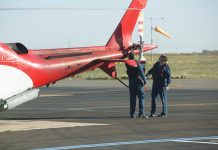CASA’s airworthiness and flying operations inspectors travel over every part of this huge country as they inspect and advise aircraft operators ranging from air transport to aerial mustering. But despite the variety of landscape and operations, some depressingly common patterns emerge in the list of things not done right.
These are issues which may seem small in themselves but often occur in clusters rather than individually. And arguing they don’t always lead to disaster is missing the point in a big way. These omissions and deficiencies are textbook examples of the late James Reason’s Swiss cheese theory – holes in accident defences that are opened, maintained and widened by habit, culture, myth or misunderstanding.
Flight Safety Australia spoke with CASA Aviation Maintenance Safety Advisor Peter Ball about how to close these holes before you or your organisation fall into them. In safety terms these are low-hanging fruit, easily plucked and managed by individuals and organisations – if they have the will.
1. Maintenance release issues
Generally, these are due to lack of education or lack of induction into an organisation,’ Ball says. ‘And oftentimes there’s a registered operator who maybe doesn’t understand what the requirements are and what it takes to be compliant.
‘The requirement is, if you’re going to fly X number of flights over X number of days with X number of hours, you need to review the maintenance release and make sure that there’s no maintenance due for the intended period of operation so the maintenance release is going to remain valid.
‘Once the maintenance is due, the maintenance release ceases to be in force. So, people are basically flying outside the protections of the maintenance release and that can also bring into question whether the insurer will cover them if they have some sort of related incident.’
2. Missing, damaged or illegible placards
Aircraft placards are instructions or statements of limitations that cover everything from how to operate door handles and emergency exits to manoeuvring and never-exceed speeds.
‘It forms part of the certification basis of the aircraft and if it’s not there, essentially the aircraft is unairworthy, because a placard would not be there unless the issue was important,’ Ball says.
Occasionally airworthiness directives mandate changes that mean a placard is no longer required, but more often they fade away or disappear from neglect. ‘The damage can be insidious, it could happen very gradually over time, fading from ultraviolet light or the passage of hands across handles and windows,’ he says.
The requirements for placards can be found in the aircraft flight manual.
3. Missing, damaged or illegible or expired compass correction cards
This is self-explanatory – or ought to be, Ball says. ‘Any direct reading magnetic compass fitted to an aircraft should have a compass card with the corrections. Even if there are no corrections, it should be there with all the zeros on it and a date and certification.
‘I guess in the day of everyone following the magenta line, this may be easily overlooked in everyday flying, but it’s still important. The magenta lines can disappear if high heat and lack of electrons shuts down your portable electronic device.
‘Then you’re back to your paper map and direction indicator (DI) and you rely on the magnetic compass to make sure the DI is reading right.’

4. Frayed seat belts
‘This seems to just sneak up on people but it’s part of the daily inspection criteria to ensure seat belts are installed, correct and fit for purpose. No fraying is acceptable. They need to be in a perfect condition. How would you feel about a loved one relying on a less than serviceable seatbelt in an emergency?’
5. Large nicks in propeller blades
‘I’m going to be a bit of a broken record here: daily inspection,’ Ball says.
‘It’s not the nick that you’ve got to be worried about. It’s the commencement of a crack. Large nicks are likely to cause cracks. And cracks can go from small to big in prop blades very quickly. And if you lose a section of propeller blade, you’re either going to have a very short flight or a tragedy on your hands.
‘When will a nick turn into a crack? How long is a piece of string? We don’t know. But if your life is hanging on that piece of string, don’t go rushing to find out.
‘If you detect a nick at the end of the day’s flying, you must put that in the maintenance release to make sure it’s attended to before the flight the next day.’
6. GPS software out of date
‘The point here is the same as with all computer systems: garbage in garbage out,’ Ball says.
‘If you’re relying on GPS as your primary source of navigation data, then if that data is not up to date, then it can’t be relied upon. And our airworthiness and flying operations inspectors have found some aircraft with trouble, no compass card and out of date GNSS data.’
7. Landing gear oleo struts
‘This is a bugbear of mine, as an aircraft maintenance engineer,’ Ball says.
‘The oleo strut is there for a reason. It’s like shock absorbers on your car: if it’s left unchecked you might be up for a whole new landing gear or worse – structural damage to the aircraft.’
Properly functioning oleos are especially important on aircraft with retractable landing gear, Ball says. ‘If the gear is retracted when the oleo strut is not fully extended, it can cause damage to the landing gear system and the aircraft may have to be landed with the gear not correctly extended.’
Even on a fixed gear aircraft, it only takes one cross-wind landing, one challenging landing, one hard landing to expose the shortcomings of gear that might perform perfectly well when landing on a paved strip on a still day. Struts may collapse suddenly and or develop a leak and lose all of their nitrogen and or fluid.
The solution? Once again – if you see a problem put it in the maintenance release and have it addressed.

8. Loose items in the cockpit
‘These days everyone has a variety of devices on hand such as phones and cameras for example, but these can become missiles in the advent of turbulence,’ Ball says.
The problem is not confined to loose devices. Inadequate restraints can fail, as they did in the case of a Robinson R44 flying over Kosciuszko National Park last year when the pilot’s mobile phone cradle fell to the floor. The pilot conducted a precautionary landing but the helicopter skid caught on alpine tussock grass and the machine overturned. No one was hurt in this crash but in 2022 both pilots of a CH-47 Chinook helicopter fighting fires in Oregon, US, died when an iPad came loose and jammed the pedals.
Loose or inadequately restrained cargo or equipment can smash instruments, break windows and change the centre of gravity.
‘Also, with helicopters, anything that comes out of the cabin can potentially get into the tail rotor system and that’ll bring that flight to an abrupt end,’ Ball says.
9. Flight manuals not current
Continuous airworthiness management of the aircraft is the responsibility of the registered operator (certificate of registration holder). If the pilot accepts the aircraft with an invalid flight manual by signing the daily inspection, then a level of responsibility falls on them.
‘The flight manual is how to operate the aircraft in the field,’ Ball says. ‘Without it you’re relying on knowledge in people’s heads, which, as we’ve already discussed may be not up to date or just plain wrong.
‘Some of the information might be in the pilot operating handbook (POH) but some aircraft don’t have a POH. Often there’ll be a supplement for the GPS, or there should be. Too often people perform a modification to the aircraft such as fitting a GPS but then forget to put in the instructions in the flight manual on how to use it.’
10. Weight and balance
‘There seems to be a tradition that as the hours go up, people get the delusion that they can wing it, they can estimate, because they’ve done it before,’ Ball says. ‘No. It’s got to be calculated every time. If you get ramp checked, you need to be able to produce something to say that you’ve done an assessment.’
Weight and balance calculation is easier and more accurate in the era of electronic flight bags (EFBs), which are approved for the purpose. If the data is correct, you just put in the numbers and it indicates in the range or puts up a little red flag if there’s anything that’s a concern.
Another weight and balance trap is to blithely assume the situation will improve as the aircraft burns fuel. But lessening of total weight could also involve an unfavourable change in centre of gravity, as happened to a heavily loaded Beechcraft Baron 55 flying from Sydney to Cooma in June 1992. As fuel burned off the C of G moved backwards, rendering the elevators ineffective and stalling the aircraft. Everyone on board died.







Comments are closed.